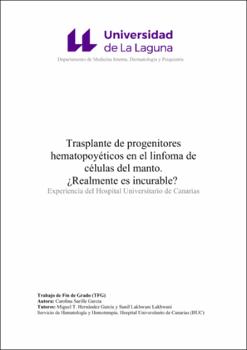Trasplante de progenitores hematopoyéticos en el linfoma de células del manto. ¿Realmente es incurable? Experiencia del Hospital Universitario de Canarias
Author
Sarille García, CarolinaDate
2020Abstract
Objetivo: Analizar la posibilidad de curación del linfoma del manto y describir
si el tratamiento intensivo con acondicionamiento con Zevalin® puede tener un plateau
en la supervivencia libre de progresión. Entre los objetivos secundarios hemos planteado
algunos relacionados con la toxicidad, aparición de neoplasias secundarias, grado de
cumplimiento de los tratamientos etc…
Material y métodos: Se ha estudiado de manera retrospectiva la historia clínica
y terapéutica de 23 pacientes trasplantados en el Hospital Universitario de Canarias por
linfoma del manto entre enero de 2005 y diciembre de 2019. Se han recogido y analizado
los datos necesarios para esclarecer las curvas de supervivencia y demás estudios
estadísticos que se ha propuesto.
Resultados: Queda demostrada la existencia de un plateau en la curva de
supervivencia de los pacientes seleccionados que han llevado a cabo un tratamiento
intensivo con R-Hyper-CVAD o similar, acondicionamiento con Z-BEAM y trasplante
de progrenitores hematopoyéticos autólogo en primera línea con una Supervivencia
Global (SV) del 70,5% proyectada a 13 años y una Supervivencia Libre de Progresión
(SLP) del 69,7% proyectada a 13 años también, observándose dicho plateau de la curva
desde los 3,7 años. Además, se analizó la toxicidad del R-Hyper-CVAD y se concluyó
que se trata de un compuesto altamente tóxico pero muy efectivo. También estudiamos
el número de pacientes que necesitaron un reajuste de dosis o suspensión del tratamiento
debido a dicha toxicidad y podemos decir que el 38.1% de los pacientes no terminaron
el tratamiento por la no tolerancia a este. No se encontró una toxicidad importante del
Zevalin® y tampoco se produjeron neoplasias secundarias al tratamiento durante el
periodo estudiado. El 85,7% de los pacientes consiguieron movilizar progenitores
hematopoyéticos de manera exitosa durante el tratamiento intensivo. Background: The aim of this study is to analyse the possibility of remission in
patients with mantle cell lymphoma and describe if intensive treatment with Zevalin®
can create a plateau effect during life-long remission. Some of the secondary aims of
this study looked into toxicity, secondary neoplastic disease, treatment compliance,
etc…
Methods: this study was retrospective. Data collected included the medical and
clinical history of 23 mantle cell lymphoma patients who had received a (bone marrow)
transplant in the Hospital Universitario de Canarias (Canaries University Hospital)
between January 2005 and December 2019. The data collected was analysed to plot the
survival curve and further statistical analysis was carried out.
Findings: This study demonstrated that there was a plateau on the survival
curve among selected patients who had had intensive treatment with R-Hyper-CVAD
or similar, treatment with Z-BEAM and autologous haematopoietic precursors
transplant as first line treatment. The global survival rate for the first 13 years was of
70.5% and the free progression survival rate was of 69.7%, also for the first 13 years.
Therefore, the plateau effect was observed after 3.7 years. In addition, the toxicity of
R-Hyper-CVAD was investigated. The findings of this study determined that it was a
highly toxic compound with a high treatment efficacy. Patients who required a change
in their treatment, whether it was dosage or suspension, were also looked at in this
research due to its toxicity. It was determined that a total of 38.1% of the sample
population did not finish their treatment due to the toxicity of it and the subsequent side
effects. High toxicity levels of Zevalin® were not found and there was no secondary
neoplastic disease related to treatment among subjects. To conclude, total of 85.7% of
patients were successful in developing autologous haematopoietic precursors during
their treatment.





